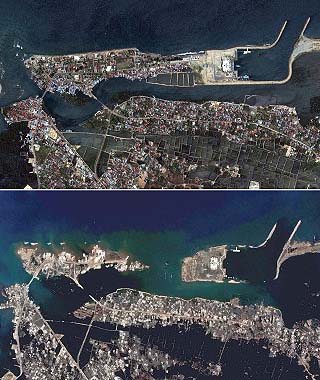| . |  |
. |
Beijing (XNA) Jan 24, 2005 An early warning system for weather disasters, a key part of China's meteorological strategic research programme, will be ambitiously upgraded this year. The system includes six major efforts: in calamity monitoring, forecasting, early warning, information processing, public broadcasting, disaster assessment, emergency response and decision-making, officials said. Based on overall assessments of calamities, the China Meteorological Administration (CMA) and its agencies throughout the country will help local authorities to work out precautionary schemes to fight extreme weather conditions and mitigate possible damage caused. "Every year, the average direct economic loss caused by catastrophic disasters, particularly, typhoon, destructive gales, rainstorm and consequent geological hazards like mud flows, accounts for 3-6 per cent of the nation's gross domestic product," Qin Dahe, CMA's top official, told a national conference which ended on Friday. Qin pledged to upgrade weather forecasting and climate prediction for such disasters to help mitigate the losses they may cause. "What we are going to do is to keep an eye on such calamities in an all-around way and issue early warnings for the public and the decision-makers," Qin said. Meteorological authorities will build the warning system through using supercomputer-based data-collecting and information processing channels, satellites and a national weather radar network. Over the past years, China has installed 74 sets of the world's advanced Doppler weather radar with 87 per cent put into operation. This year, 30 other new devices of the same type are scheduled to be in place with a satellite launched later last year expected to start its operations following full orbital testing. "Weather forecasters will be able to watch the weather and climate changes 24 hours a day with the help of such a system when all things ready for operation," Zhang Guocai, director of CMA's Department of Forecasting Services and Disaster Mitigation, said on Friday in Beijing. He was confident that, by then, weather forecasting can be made as detailed as possible for the public to know when and where disasters like typhoons, floods and gales, are to happen. "This year, we will introduce a colourcoded weather warning system nationwide to issue information about extreme weather conditions including typhoons, rainstorms, heat and cold waves, fog, sandstorms, lightning storms, gales, hailstorms, snowstorms and road icing," Zhang said. The warnings will be issued alongside images and words in Chinese and English and broadcast on TV, radio and in text messages to people via mobile phones along with other possible means of mass distribution like electronic billboards in downtown areas and freeways. "It will help people prepare for and avoid the harm of bad weather and enable decision-makers to know about impending calamities as early as possible," he said. "People in areas of risk can be saved with consequent damages mitigated with warnings issued 3 hours ahead of upcoming disasters," Zhang added. Source: Xinhua News Agency Related Links SpaceDaily Search SpaceDaily Subscribe To SpaceDaily Express  Rome, Italy (SPX) Jan 24, 2005
Rome, Italy (SPX) Jan 24, 2005An FAO-produced Atlas on areas affected by the 26 December 2004 tsunami in Southeast Asia has proven to be very useful to FAO teams and to Italian and other European officials and non governmental organizations working in the devastated zones. |
|
| The content herein, unless otherwise known to be public domain, are Copyright 1995-2006 - SpaceDaily.AFP and UPI Wire Stories are copyright Agence France-Presse and United Press International. ESA PortalReports are copyright European Space Agency. All NASA sourced material is public domain. Additionalcopyrights may apply in whole or part to other bona fide parties. Advertising does not imply endorsement,agreement or approval of any opinions, statements or information provided by SpaceDaily on any Web page published or hosted by SpaceDaily. Privacy Statement |